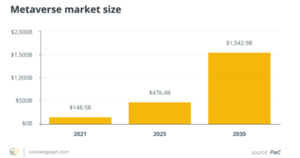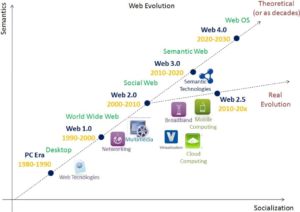Hi everyone! This is Mr. Daniel, welcome back to another newsletter!
Metaverse, Omniverse, our future social media universe are extremely transformative. Innovative companies are making their stake now in the future Metaverse. Technological advancements, decentralized finance (DeFi), Non-Fungible Tokens (NFT), Artificial intelligence, autonomous robotaxi, blockchain technology & DNA genomics are going to have huge disruptive effects on the economy and our lives.
These technologies have been improving and brewing in the background since 2000. Covid pandemic has been the decisive biological catalyst for changing the world.
I think everyone, especially high school and college students need to rethink their future and how much our world will change in 5 to 10 year.
This also means learning new skills not taught in school.
Traditional curriculum is Math (Algebra, Trig and Calculus) and Science (Bio, Chem and Physics) are NOT caught up with the technological advancements. In my AP biology class, we still use Textbooks that are dated in content. Students are still learning the technology from more than 20 years ago. There are no updates on exciting fronts such as CRISPR, DNA Sequencing and AI applications, just to name a few.
Textbooks still focus too much on repetition & memorization instead of critical thinking. Unfortunately, textbooks are outdated and students are NOT taught how to use textbooks properly to get the best out of learning.
So, learning and applying what you learned now falls on your own shoulders.
Stay curious, ask questions and always try to delve deep into your questions. Keep asking WHY and do not settle for simple answers.
Find a great mentor and start learning how to learn.
Here are some of the new world skills below I think everyone should look into.
- Science – DNA and genomics technology and research. Search for internship & research opportunities beyond the classroom.
- Software programming (coding languages and how they are used to create our world). High school and college still focus on mandatory and broad general education. Only C++ and Java are introduced in high school, often at a very low level. If you are interested in technology, coding like Python is a must learn. Coding is difficult, start when you are ready and as with everything else, coding will become easier with time.
- Critical thinking skills. Laboratory work, group projects, ability to understand and form an opinion on any topics. This is one of the reasons for starting this newsletter. Read as much as you can, blogg and write about what you read.
- Interconnected social skills. EQ, social skills, and speaking skills are not taught in school Can you engage in a lively conversation with adults? Or are you too shy and only answer in yes or no’s?
- AI & Machine Learning applications are in everything. However, there are no curriculums in high school. Even in UC colleges, students are required to use 2 years to satisfy more General requirements beyond K-12 that may not have direct world relevance.
4 year college can go by really fast and without a real plan, time is therefore wasted.
Read about AI and Machine learning applications. To name a few,
- Robotics in warehouses and manufacturing,
- Green energy to replace fossil fuel dependence,
- Energy Storage & Energy Utility,
- Machine learning and nanobots in cancer and medicine.
- Business entrepreneurship skills in Blockchain technology, as used in Web 3.0, NFTs, gaming and in the future virtual Metaverse
Find something you are interested in and major in it, get real industry experience as soon as you can. This way you can explore your career path early.
We all need to embrace new technology and take advantage of this once in a lifetime tsunami of transformation that is coming in the next 5 to 10 years.
In addition, I would like to discuss Web 1, 2 and Web 3.0
Web 1.0 (1990-1999)
Read-only, static web.
This is an informational web where data is posted on the internet and users can read the information. The interaction is one way. Static, personal websites and google search are examples.
Web 2.0 (2000-2012)
Read-write, Interactive and platform-based web
Web 2.0 allows users to interact, post video, blogg and input data. These are powered by platform-driven big tech companies.
Web 2.0 is an app on a server with an Application Program Interface (API)and Database. API allows different applications to communicate with each other and allow access to databases.
Like Google/YouTube, Meta/Instagram (Facebook), Tiktok, Uber, Twitter are good examples of Web 2.0
Web 3.0 (2012-present) still evolving.
Read-write-execute, blockchain backed web.
Web 3.0 is the paradigm for new user interaction! Virtual and augmented reality in the digital Metaverse and omniverse. In Web 3.0, users can read, write and also can execute transactions recorded by blockchain. There is no centralized platform like Facebook that creates user rules and regulations. Web 3.0 transactions are community based and users and creators can own a piece of the internet community using cryptocurrency. This is ownership on a new level.
Just recently, investors have been buying up virtual land and properties in anticipation for Metaverse, especially after Meta’s CEO Mark Zuckerberg and Nvidia CEO Jensen Huang’s reveal of their versions of the digital universe. The Metaverse market cap is expected to hit $1.5 Trillion by 2030 and the virtual economy will be powered by different cryptocurrencies.

According to Yahoo News,
“The Sandbox – one such virtual world – is leading the pack with both the highest number of traders and sales. The Sandbox also boasted the highest trading volume last week, taking in more than $86 million, while Decentraland followed in second place with more than $15 million traded for land plot NFTs”
Note to self:
Sandbox is a gaming virtual world built on ethereum blockchain. As a player, you can build (like advanced minecraft), own and trade NFTs or SAND cryptocurrency. This is gaming monetized!
Imagining playing and creating and making a living at the same time! You can create in-game NFT assets (like tools, creatures, real estate, etc.), put them onto Sandbox’s decentralized marketplace and trade them using cryptocurrencies! This is the power of blockchain and a glimpse of what Web 3.0 is currently being used. The users and creators on Sandbox have digital ownership powered by blockchain technology.
Think bigger.
There are multi-metaverses created by people across the world. Sandbox is only one such metaverse that you can warp into, buy a piece of land (only 166,464 plots of land is available on Sandbox metaverse) and build whatever experiences you want. In the future, we may be able to warp from one virtual metaverse to another metaverse in virtual reality!
These multi-verses will have a real digital economy and people living in virtual lives!
Web 3.0 is different from Web 1, 2 and uses a decentralized app (dapp) where the communication is peer to peer and the database is stored and secured on blockchain instead of one computer.
In this fashion, Web 3.0 allows users to execute transactions directly (often using ether powered smart contracts) instead of relying on a centralized organization. No single authority can control and censor the user community.
Apple’s Siri, Openseas for NFT trading, 3D virtual reality with avatar, Meta’s (Facebook) invite to developers to create digital products, NFT Gaming are examples of the evolving Web 3.0.

Currently there are many cryptocurrency projects and their user communities. You receive ownership by simply using and participating in these projects. If the project is well received and is growing, the project’s cryptocurrency will boost in value and in market cap.
For example, Cardano is a blockchain and uses Ada as its cryptocurrency. https://cardano.org/discover-cardano#people
Cardano founder Charles Hoskinson is an entrepreneur and programmer, one of the eight co-founder of Ethereum. Hoskinson and his team have projects that are helping and educating people from the developing world to adopt cryptocurrency and blockchain. He is on a mission to expand technology and improve the lives of many from the developing nations!
This is what Cardano stands for:
“Cardano is built by a decentralized community of scientists, engineers, and thought leaders united in a common purpose: to create a technology platform that will ignite the positive change the world needs”
The cryptocurrency is Ada, people who invest in Cardano and invest in Ada:
“Every ada holder also holds a stake in the Cardano network. Ada stored in a wallet can be delegated to a stake pool to earn rewards – to participate in the successful running of the network – or pledged to a stake pool to increase the pool’s likelihood of receiving rewards. In time, ada will also be usable for a variety of applications and services on the Cardano platform”
2030 is coming in 9 years!
Having the proper mindset of the future and constantly learning these new-world skills will make a huge difference in your life and future goals.
Imagine having this for an extracurricular activity on your application,
Career related:
A Virtual Business Entrepreneur, Founder of SANDBOX University
9,10,11,12
School
6hr/wk, 50 wk/yr
Continue
Creator & programmer of digital and NFT assets in SANDBOX Metaverse. I financed a virtual land and built a SANDBOX University that educates teens from African countries on blockchain adoption and personal finance. Avid investor in Cardano humanitarian projects.
2030 is not too far away.
Current 9th graders will have graduated college and entered the workforce or graduate school.
Current college students will be working or will have finished professional or graduate school.
Mark the calendar, 2030 will be a very exciting world.
Plan your extracurricular activities, your future major and careers so you won’t miss out on opportunities.
Thanks for your readership,
See you next time!
Best
Mr. Daniel
嗨,大家好!我是 Daniel 先生,歡迎回到另一期時事通訊!
Metaverse、Omniverse ,我們未來的社交媒體世界都極具變革性。創新公司現在正在未來的元界中佔有一席之地。技術進步、去中心化金融 (DeFi) 、非同質化代幣 (NFT) 、人工智能、自主機器人出租車、區塊鏈技術和 DNA 基因組將對經濟和我們的生活產生巨大的破壞性影響。
自 2000 年以來,這些技術一直在不斷改進和醞釀。Covid疫情一直是改變世界的決定性生物催化劑。
我認為每個人,尤其是高中生和大學生都需要重新思考他們的未來以及我們的世界在 5 到 10 年內會發生多大的變化。
這也意味著學習學校沒有教授的新技能。
傳統課程是數學(代數、三角函數和微積分)和科學(生物、化學和物理)沒有趕上技術進步。在我的 AP 生物課上,我們仍然使用內容過時的教科書。學生們仍在學習 20 多年前的技術。CRISPR、DNA 測序和人工智能應用等激動人心的前沿領域沒有更新,僅舉幾例。
教科書仍然過多地關注重複和記憶,而不是批判性思維。不幸的是,教科書已經過時,學生沒有被教導如何正確使用教科書以充分利用學習。
所以,學習和應用你現在學到的東西落在了你自己的肩上。
保持好奇,提出問題,並始終嘗試深入研究您的問題。不斷問為什麼,不要滿足於簡單的答案。
找到一位優秀的導師並開始學習如何學習。
以下是我認為每個人都應該研究的一些新世界技能。
- 科學 – DNA 和基因組學技術與研究。尋找課堂以外的實習和研究機會。
- 軟件編程(編碼語言以及如何使用它們來創造我們的世界)。高中和大學仍然專注於強制性和廣泛的通識教育。高中只介紹了 C++ 和 Java,且只為基礎入門知識。如果你對技術感興趣,像 Python 這樣的語言是必須學習的。程設很困難,當你準備好時開始,就像其他一切一樣,隨著時間的推移,程設會變得更容易。
- 批判性思維能力。實驗室工作、小組項目、理解任何主題並形成意見的能力。這也是我決定寫時事通訊的原因之一。盡可能多地閱讀,寫博客並寫下你閱讀的內容。
- 相互關聯的社交技能。情商、社交技巧和口語技巧不是在學校專門教授的。你能和大人進行熱烈的交談嗎?還是你太害羞,只回答是或否?
- 人工智能和機器學習應用無所不在。但是,高中沒有課程。即使在UC 大學,學生也需要用 2 年的時間來滿足 K-12 以外的更多通用要求,這些要求可能與世界沒有直接關係。
4 年大學可以過得非常快,沒有真正的計劃,因此浪費了時間。
閱讀有關 AI 和機器學習應用程序的信息。僅舉幾例,
- 倉庫和製造業中的機器人技術,
- 綠色能源取代對化石燃料的依賴,
- 能源儲存和能源公用事業,
- 癌症和醫學中的機器學習和納米機器人。
- 區塊鏈技術中的商業創業技能,用於 Web 3.0、NFT、遊戲和未來的虛擬元界
找到自己感興趣的專業,盡快獲得真正的行業經驗。通過這種方式,您可以儘早探索自己的職業道路。
我們都需要擁抱新技術,並在未來 5 到 10 年即將到來的轉型海嘯中利用這一點,這將是一生一次的機會。
另外,我想討論一下 Web 1、2 和 Web 3.0
Web 1.0 (1990-1999)
僅限讀取的靜態網絡。
這是一個信息網絡,數據發佈在互聯網上,用戶可以閱讀這些信息。一種單向的互動方式。個人網站和谷歌搜索就是例子。
Web 2.0 (2000-2012)
讀寫、交互和基於平台的網絡
Web 2.0 允許用戶交互、發布視頻、博客和輸入數據。這些由平台驅動的大型科技公司提供支持。
Web 2.0 是服務器上的應用程序,具有應用程序接口 (API) 和數據庫。API 允許不同的應用程序相互通信並允許訪問數據庫。
像 Google/YouTube、Meta/Instagram (Facebook)、Tiktok、Uber、Twitter 都是 Web 2.0 的好例子
Web 3.0(2012 年至今)仍在不斷發展。
讀寫執行,區塊鏈支持的網絡。
Web 3.0 是新用戶交互的範例!數位 Metaverse 和 omniverse 中的虛擬和增強現實。在 Web 3.0 中,用戶可以讀、寫,也可以執行區塊鏈記錄的交易。沒有像 Facebook 這樣創建用戶規則和規定的中心化平台。Web 3.0 交易是基於社區的,用戶和創建者可以使用加密貨幣擁有互聯網社區的一部分。這是一個新高度的所有權。
就在最近,投資者一直在為 Metaverse 購買虛擬土地和財產,尤其是在Meta 的首席執行官馬克扎克伯格和英偉達首席執行官黃仁勳公佈他們的數位宇宙之後。到2030 年,Metaverse 市值預計將達到1.5 萬億美元,虛擬經濟將由不同的加密貨幣提供動力。

據雅虎新聞報導,
“沙盒—一個這樣的虛擬世界—以最高的交易者數量和銷售額領先。沙盒上週的交易量也最高,超過 8600 萬美元,而Decentraland位居第二,超過1500 萬美元用於土地 NFT 交易”
值得關注的一點:
沙盒是一個建立在以太坊區塊鏈上的遊戲虛擬世界。作為玩家,您可以構建(如創世神裡)、擁有和交易 NFT 或 SAND 加密貨幣。這是遊戲貨幣化!
一邊玩一邊想像著創造和謀生!您可以創建遊戲中的 NFT 資產(如工具、生物、房地產等),將它們放入 Sandbox 的去中心化市場並使用加密貨幣進行交易!這就是區塊鏈的力量,也是目前正在使用的 Web 3.0 的一瞥。Sandbox 上的用戶和創建者擁有由區塊鏈技術支持的數字所有權。
想得更大。
世界各地的人們創造了多元宇宙。Sandbox 只是一個這樣的 Metaverse,您可以變形,購買一塊土地(Sandbox Metaverse 上只有 166,464 塊土地可用)並構建您想要的任何體驗。未來,我們或許可以在虛擬現實中從一個虛擬的元節躍遷到另一個元節!
這些多元宇宙將擁有真正的數位經濟和生活在虛擬生活中的人們!
Web 3.0與 Web 1、2 不同,它使用去中心化應用程序 (dapp),其中通信是點對點的,並且數據庫存儲在區塊鏈上,而不是在一台計算機上進行保護。
通過這種方式,Web 3.0 允許用戶直接執行交易(通常使用以太驅動的智能合約),而不是依賴於一個集中的組織。沒有任何一個機構可以控制和審查用戶社區。
Apple 的 Siri、用於 NFT 交易的 Openseas、帶有頭像的 3D 虛擬現實、Meta (Facebook) 邀請開發人員創建數字產品、NFT Gaming 都是不斷發展的 Web 3.0 的例子。

目前有許多加密貨幣項目及其用戶社區。您只需使用和參與這些項目即可獲得所有權。如果該項目受到好評並且正在增長,則該項目的加密貨幣的價值和市值將會增加。
例如,Cardano 是一個區塊鏈,使用 Ada 作為其加密貨幣。https://cardano.org/discover-cardano#people
卡爾達諾創始人查爾斯霍斯金森是一位企業家和程序員,以太坊八位聯合創始人之一。Hoskinson 和他的團隊的項目正在幫助和教育來自發展中國家的人們採用加密貨幣和區塊鏈。他的使命是擴展技術並改善許多發展中國家的生活!
這就是卡爾達諾所代表的:
“卡爾達諾是由科學家、工程師和思想領袖組成的分散社區建立的,他們團結在一個共同的目標上:創建一個技術平台,點燃世界所需的積極變化”
加密貨幣是Ada,投資Cardano並投資Ada的人:
“每個 ada 持有者還持有 Cardano 網絡的股份。存儲在錢包中的 Ada 可以委託給一個股份池以獲得獎勵—參與網絡的成功運行—或質押到一個股份池以增加池的可能性獲得獎勵。隨著時間的推移,ada 也將可用於 Cardano 平台上的各種應用程序和服務”
9年後2030年即將到來!
擁有正確的未來心態並不斷學習這些新世界的技能將對您的生活和未來目標產生巨大的影響。
想像一下,在您的大學申請中展現以下的課外活動,
職業相關:
虛擬商業企業家,沙盒大學創始人
9、10、11、12
學校
6 小時/週,50 週/年
持續性
SANDBOX Metaverse 中數位和 NFT 資產的創建者和程序員。我資助了一塊虛擬土地並建立了一所沙盒大學,對來自非洲國家的青少年進行區塊鏈採用和個人理財方面的教育。卡爾達諾人道主義項目的狂熱投資者。
2030年並不遙遠。
當前的 9 年級學生將大學畢業並進入勞動力市場或研究生院。
目前的大學生將工作或將完成專業或研究生院。
記下日曆,2030 年將是一個非常令人興奮的世界。
計劃你的課外活動、你未來的專業和職業,這樣你就不會錯過機會。
感謝您的閱讀,
下次見!
丹尼爾先生



